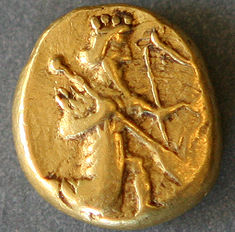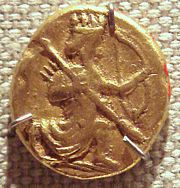
Persian daric
Encyclopedia

Coin
A coin is a piece of hard material that is standardized in weight, is produced in large quantities in order to facilitate trade, and primarily can be used as a legal tender token for commerce in the designated country, region, or territory....
used within the Persian Empire. It was of very high gold quality, with a purity of 95.83%. Weighing around 8.4 gram
Gram
The gram is a metric system unit of mass....
s, it bore the image of the Persian king or a great warrior
Warrior
A warrior is a person skilled in combat or warfare, especially within the context of a tribal or clan-based society that recognizes a separate warrior class.-Warrior classes in tribal culture:...
armed with a bow
Bow (weapon)
The bow and arrow is a projectile weapon system that predates recorded history and is common to most cultures.-Description:A bow is a flexible arc that shoots aerodynamic projectiles by means of elastic energy. Essentially, the bow is a form of spring powered by a string or cord...
and arrow
Arrow
An arrow is a shafted projectile that is shot with a bow. It predates recorded history and is common to most cultures.An arrow usually consists of a shaft with an arrowhead attached to the front end, with fletchings and a nock at the other.- History:...
, but who is depicted is not known for sure. The coin was introduced by Darius the Great
Darius I of Persia
Darius I , also known as Darius the Great, was the third king of kings of the Achaemenid Empire...
of Persia some time between 522 BC and 486 BC
486 BC
Year 486 BC was a year of the pre-Julian Roman calendar. At the time, it was known as the Year of the Consulship of Viscellinus and Rutilus...
and ended with Alexander the Great's invasion in 330 BC
330 BC
Year 330 BC was a year of the pre-Julian Roman calendar. At the time, it was known as the Year of the Consulship of Crassus and Venno...
. Upon the invasion of Persia by Alexander they were melted down and recoined as coins of Alexander. This is believed to be the main reason for their rarity in spite of their widespread usage at the time.
Close to the end of the 5th century BC, the Persian satraps in Asia Minor decided to strike their own coins. Darius considered such encroachment a crime punishable by death since the right of coinage was treated as an exclusively royal prerogative. The numismatic evidence does not permit identification of the image on the darics and sigloi as anything but that of the emperor; it was adopted by Darius as a dynamic expression of his royal power expressly for his coin issues.

Old Testament
The Old Testament, of which Christians hold different views, is a Christian term for the religious writings of ancient Israel held sacred and inspired by Christians which overlaps with the 24-book canon of the Masoretic Text of Judaism...
, as the Israelites came into contact with it when their Babylonian conquerors were conquered by Persia. The first Book of Chronicles
Books of Chronicles
The Books of Chronicles are part of the Hebrew Bible. In the Masoretic Text, it appears as the first or last book of the Ketuvim . Chronicles largely parallels the Davidic narratives in the Books of Samuel and the Books of Kings...
describes king David
David
David was the second king of the united Kingdom of Israel according to the Hebrew Bible and, according to the Gospels of Matthew and Luke, an ancestor of Jesus Christ through both Saint Joseph and Mary...
as asking an assembly of people to donate for the construction of the Temple. The people gave generously "for the service of the house of God five thousand talents and ten thousand darics of gold, ten thousand talents of silver, eighteen thousand talents of bronze, and one hundred thousand talents of iron." Since David's reign is believed to be between c. 1048 and c. 1007 B.C. according to Old Testament chronology, the use of the daric is either an anachronism
Anachronism
An anachronism—from the Greek ανά and χρόνος — is an inconsistency in some chronological arrangement, especially a chronological misplacing of persons, events, objects, or customs in regard to each other...
or a conversion by the writer into contemporary units.
In the ancient times, it was nicknamed "the archer". For instance, Agesilaus said that he had been driven out of Asia by thirty thousand archers, referring to the bribe distributed by the Persian King.
There is also a double daric issued either by Darius III or Alexander around 350 BC
350 BC
Year 350 BC was a year of the pre-Julian Roman calendar. At the time it was known as the Year of the Consulship of Laenas and Scipio...
- 330 BC
330 BC
Year 330 BC was a year of the pre-Julian Roman calendar. At the time, it was known as the Year of the Consulship of Crassus and Venno...
but information on this is scarce.
Some, such as the Ancient Greeks, believed that this coin's name is derived from the name Darius, but in reality it appears to be derived from a Persian word meaning "gold"; in Middle Persian it is called zarig.

